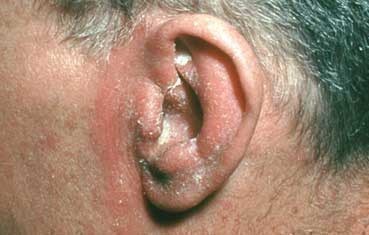Can adults get cradle cap? Although it is most common in babies, cradle cap in adults could also occur. Cradle cap adult symptoms are no different from those experienced in babies. As such, cradle cap treatment for adults is almost the same. We explore how to get rid of cradle cap in adults.
Can Adults Get Cradle Cap?
In medical terms, cradle cap is known as seborrheic dermatitis. This is most common in children who are less than eight months old. It is a scalp condition which almost every child gets. This though does not mean that it is only found in children. Can adults get cradle cap? It is possible for adults to experience seborrheic dermatitis which is mostly referred to as dandruffs.

Although this tends to be an uncomfortable and embarrassing condition, it is in no way harmful to your health. As such, one does not need to see a doctor for the same unless the condition interferes with their daily life, is painful, becomes itchy, gets infected or persists even after proper home care.
The crusty appearance of cradle cap may be unsightly but it is not contagious. It is also not a sign of a lack of cleanliness or allergies. It however can be as a result of neurological disorders. An over productivity of the sebaceous glands could also cause cradle cap in adults.
To get rid of it, one could visit their hairdresser who could put them on medicated shampoos. These normally contain active ingredients that are capable of getting rid of the cradle cap. These can be used on a daily basis and usage cut down with time as the condition gets better. Of great importance when treating adult cradle cap is to follow the instructions given in treatment products.
How fast one gets rid of it will depend on severity of the condition. At times, some hair loss may be experienced. The scalp will also tend to appear flaky, greasy and itchy. It at times may also become red. In severe cases the condition may spread beyond the scalp to affect the ears and eyebrows.
It is normally suggested that one cuts back their consumption of sugars and yeasty foods. Increasing vegetables intake will go a long way in helping to get rid of toxins from the body and can help in speeding up the process of healing. Being consistent in the preferred mode of treatment will play a great role in hastening the healing process.
What Causes Cradle Cap in Adults?
It is not known what the exact cause of cradle cap in adults is but it is suspected that some things could be risk factors. The condition I most common in adults aged between 30 and 60. Changes in weather, being obese, infrequent shampooing neurologic disorders, heredity and having acne all act as risk factors for getting dandruff. The above risk factors increase the possibility of an overgrowth of the malassezia fungus and hormonal changes. Some of the specific causes include:

- Excessive production of sebum
- Yeast infection on the skin
- Weak immune system
- Inflammation
- Insufficient cleaning
- Products containing alcohol
- Neurological disorders
Cradle Cap Adults Symptoms
When it occurs, cradle cap adults symptoms are easy to identify. The symptoms will start off being slight before developing into severe signs if the condition is not taken care of in the initial stages. The affected scalp will appear flaky scaly and greasy. With time, some yellow or whitish flakes will start flaking from the scalps. In severe cases, one may experience hair loss, sore skin and a lot of itching. These symptoms tend to improve during the summer and are at their worst in winter.
Some of the specific symptoms are as listed below:
- Flaky scalp with flakiness extending to the face, ears and on skin folds in severe cases.
- Sticky oily scales that are whitish or yellowish. These tend to be more sticky and thicker that dandruffs. They also are attached to the hair shaft.
- In case there is an infection, the scalp will be itchy and hair loss may also be experienced. The hair loss is only temporary.
How identifiable these symptoms are will depend on how severe the condition is. While most adults only experience it on the head, very severe cases may have one exhibiting these symptoms on the face and on the neck. This though is not common.
Cradle Cap Treatment for Adults
There are different options for cradle cap treatment for adults. What one picks should depend on effectiveness, convenience and affordability. Also to be considered is the severity of the condition so as to pick the best form of treatment.

Cradle cap can be treated using over the counter medicated shampoos. These are shampoos that contain selenium sulfide, zinc pyrithione, salicylic acid and coal tar. This kind of shampoo should be used daily and when the condition gets better usage reduced to thrice per week. While using it, massage the scalp gently to enhance the loosening of the flakes. It should be left to settle in for at least five minutes after which one rinses it off.
In case over the counter shampoos fail to work, one should opt for prescription strength shampoos. A visit to the dermatologist will see him recommend shampoos that are relevant to the cause. One of these would be ketoconazole. There also are immune-modulating drugs that can be used as a short term remedy for adult cradle cap. These though should be used with caution as their long term use can have a negative effect on the immune system.
Other than those, one could make use of alternative dandruff treatments. Shampoos containing tea tree oil have antimicrobial properties and can serve as effective natural treatments for adult cradle cap. This is most effective in mild to moderate cases.
How to Get Rid of Cradle Cap in Adults
There are various ways on how to get rid of cradle cap in adults. These vary in usage and mode of application as well. Discussed below are some and how to use them. They all come with their own advantages.
- Conventional treatments: These include the use of medicated shampoos to get rid of the flakes. These are available over the counter as well as up on prescription. There also are some creams that can be used especially by persons whose condition extends beyond the scalp. Hydrocortisone creams are known to be quite effective.
- Hygiene: Paying more attention to the scalp than normal could help. One can get to wash the scalp on a daily basis. After this, use a soft brush to comb the scales off the scalp when the hair is still wet. This is most effective in mild cases.
- Probiotics: These can as well be used to help in eliminating the condition.
- Biotin: consumption of sufficient biotin will help in countering a deficiency which in the long end may contribute to the poor condition of the scalp. Countering this will go a long way in helping to get rid of it.
- Tea tree oil: This is believed to contain medicinal properties that will help the scalp heal.
- Ensuring the scalp gets sufficient sunlight is also effective. Ensure your hair is well aired and that the skin stays dry as well.
Shampoo for Cradle Cap in Adults
Cradle cap in adults is not as a result of poor hygiene or some allergies. It therefore cannot be passed from one person to another. To start its treatment, one can visit their drug store and get a bottle of medicated shampoo. These usually contain active ingredients such as salicylic acid, ketoconazole, selenium sulfide as well as tar. When used as directed, it is likely to get rid of the cradle cap.
In case over the counter shampoos do not improve the condition; one should opt for prescription strength shampoos. These are not available over the counter. They are quite strong and should be used as directed by the doctor and manufacturer.
When starting off, the shampoo for cradle cap in adults should be used every day. As the condition clears up, this can be reduced to three times in a week and further down as may be necessary. Depending on individual response and severity of the condition, it may take up different durations to have the condition clear up.
At times, you may inquire from your hair dresser on how to go about the whole shampooing process. They may be in a position to guide you in the right direction and help hasten the clearing up. In case these shampoos fail to work, it is time to see a doctor so they can diagnose and recommend further treatment.
 eTopical Precious Finds
eTopical Precious Finds


